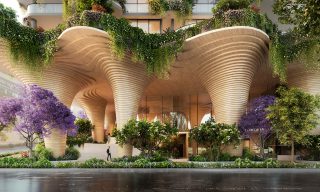When the eyes of the world pan out over Brisbane at the 2032 Olympics, it’s the fervent wish of Aria Property development director Michael Hurley that they will see a city blanketed in greenery and patched with forested buildings.
While Queensland’s vision of a “climate positive Games” is balanced by a healthy contribution from mining to the state’s economy, Aria has been in the sustainability business since its inception in 2003.

The company’s mantra is to create residential and retail projects that “we will be proud to walk our families past in 20 years’ time”.
Its 24 inner-city, high-rise developments over the last two decades have been increasingly ambitious from an environmental perspective.
They started with solar panels connected to the common areas of each building, progressed to green walls and rainwater harvesting using storm water tanks, and have introduced irrigation of planter boxes with a Wi-Fi network to monitor soil moisture levels in real time.
More recently, Aria has been adding small fleets of Tesla electric vehicles which are powered by solar panels on each building and can be hired through a phone app.
The initiative has enabled some households to cash in their second cars.
As a string of collapses have demonstrated in the post-Covid downturn, builders and developers operate on thin margins, hoping that volume will be their saviour.
Aria, for its part, says that it spends millions of dollars on sustainability and improving the amenity of its buildings. So how does it compete?
“It’s not an overly complex algorithm,” Mr Hurley said.
“As a developer you can do one of two things – compete either on price or quality and reputation, and we chose 10 or 15 years ago to go for the latter.
“We know our buildings are anywhere from 3-5 per cent more expensive than the next-door neighbour, but we invest in a way that we know we’d love to live in them.”
According to Mr Hurley, resale values in Aria buildings are higher than the competition, enabling Aria to effectively “decouple” from the market.
If the market lifted by 10 per cent, he said, Aria-branded offerings could increase in a range of 10-30 per cent.
“But it’s not just because of the sustainability; it’s the whole recipe – location, architecture, amenities, facilities and retail,” Mr Hurley said.
As a private company, Aria has greater freedom about its level of public disclosure, arguing its owners and tenants are best served by “practical” information rather than the complexity and ambiguity often found in detailed sustainability reports.
Mr Hurley said the company preferred to publish “practical” things that were capable of being measured.
“The impact of putting a solar farm on the roof can be instantly measured, performance glazing can be measured, operable front doors are measurable, as are rainwater harvesting and pull-away facades to open up your living room,” he said.
“So rather than chase a particular rating or target net zero or something else, we tend to do things that everyone can see and touch. And measure on the spot.
“Having said that, we’re a dynamic company, and it’s not to say we wouldn’t consider doing something tomorrow if we’re not doing it today.”
Mr Hurley said sustainability has always been part of Aria’s makeup but was elevated to one of the group’s five pillars – along with design, building management, public realm and amenities – with the Botanica development in Brisbane’s green-tinged, inner-city West End.
Botanica was designed 11 years ago, completed three years later and was the first of Aria’s multi-residential buildings to incorporate solar panels.
The improvement in energy efficiency helped offset electricity costs, generating savings for residents.
The real sustainability driver, however, was a visit by the group’s leaders to Singapore, where a shortage of land has prompted developers and their architects to come up with appealing, high-rise designs for sustainable living.
Five years ago, the entire company visited the island state, primed for an intensive round of research and innovation.
They met with local luminaries such as Richard Hassell, founding director of the local architectural firm WOHA and a former board member of the Urban Redevelopment Authority of Singapore and the Singapore Land Authority.
“We saw how Singapore’s climate and environment, which is very like Brisbane and caters to these beautiful, lush-green buildings,” Mr Hurley said.
“It also has a very dynamic planning system, which effectively means you can get approval for greater height if you offer amazing architecture, but you get nothing if you offer nothing. It’s the same with sustainability.
“Our first step was to design and develop a building called TreeHouse, also in the West End, which had more than 80 trees and a couple of thousand plants, and we were inspired to build Urban Forest, which we believe will be one of the world’s greenest residential buildings.
“We believe one of the most sustainable things we can do is build high-rise residential development in areas where people live, work and play.”

While Urban Forest has gone through a couple of iterations, Mr Hurley said he hoped the project, featuring 250-plus apartments and a 1350sqm park under the building, would receive final approval in the coming months.
Construction would hopefully start in the first quarter of 2025.
With the return of immigration after Covid shutdowns, the looming Olympic Games and the development of a premium market for sustainable buildings, Mr Hurley said there was a lot to be optimistic about in Queensland.
The south-east, he said, was the nation’s premier growth area.
“We believe it’s going to be a golden decade here in Brisbane, but we’ve felt that way for the last two decades,” he said.
“Anyone who thinks they can leave their state and go and do what they want to elsewhere will find it a challenge because it’s a local’s game.
“There’s the right street in the right suburb and then there’s the right part of the right street, but you wouldn’t know that unless you’re a local.”
The information contained in this article is based upon sources believed to be reliable but which have not been independently verified. Opinions or ideas expressed may not necessarily be those of National Australia Bank Limited (NAB) nor may they necessarily reflect NAB’s views or endorsement. This article is for informational purposes only.






